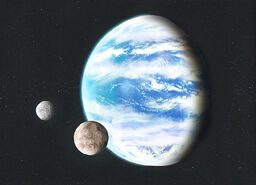Space&Herps (talk | contribs) No edit summary Tag: rte-wysiwyg |
Space&Herps (talk | contribs) No edit summary Tag: rte-wysiwyg |
||
| Line 4: | Line 4: | ||
Uranus is a gas giant with a big rocky (silicate-iron-nickel) core. Blasting off the gaseous layers of Uranus would be far beyond current technology. Afterwards, some [[atmosphere]] needs to remain and the core will cool dramatically to minus 300 degrees F. This would require warming via [[solar mirrors]] and strong [[Greenhouse Gases|greenhouse gases]], then comet bombardment. The mass of the bare core is estimated to be as small as 0.5 Earth masses or as big as 3.7 Earth masses, so the new rocky planet could be similiar to Earth in size. |
Uranus is a gas giant with a big rocky (silicate-iron-nickel) core. Blasting off the gaseous layers of Uranus would be far beyond current technology. Afterwards, some [[atmosphere]] needs to remain and the core will cool dramatically to minus 300 degrees F. This would require warming via [[solar mirrors]] and strong [[Greenhouse Gases|greenhouse gases]], then comet bombardment. The mass of the bare core is estimated to be as small as 0.5 Earth masses or as big as 3.7 Earth masses, so the new rocky planet could be similiar to Earth in size. |
||
===Terraforming Into Ocean Planet=== |
===Terraforming Into Ocean Planet=== |
||
| − | By blasting off the atmosphere and only half of its water-ammonia layer, it could be terraformed into an oceanic "[[super-Earth]]". The ocean left would completely cover the planet. Next, |
+ | By blasting off the atmosphere and only half of its water-ammonia layer, it could be terraformed into an oceanic "[[super-Earth]]". The ocean left would completely cover the planet. Next, the plamet could be heated by an orbiting fusion satellite cloud and ''powerful'' greenhouse gases to create a thick atmosphere of mostly water vapor, ammonia, and methane. Then through fairly simple chemical and biochemical reactions, water (H2O) produces oxygen via photo- and electrolysis, ammonia (NH3) is broken down into nitrogen, and methane (CH4) is burned to make carbon dioxide. The leftover hydrogen can be used as fuel for floating nuclear-fusion powerplants that would provide most of the electricity to sustain human presence. Much Uranus' worldwide ocean would be covered by Ice, allowing the construction of outposts. But to make it more Earth-like, artificial continents (made of material mined from asteroids and small moons) could be constructed and inflated with helium (the by-product of fusion) for buoyancy, thus building a foundation for cities and natural ecosystems. Genetically modified algae in the oceans could continue oxygen cycle. |
Revision as of 22:00, 8 May 2016
Teraforming of Uranus is the goal of altering Uranus's environment to sustain Terrestrial organisms. This process would be done in the far future, as we neither possess the technology that's needed to take on such a project. One very important change would be stabilizing in its extreme axial tilt of 98 degrees.
Terraforming Into an Earth-like Planet
Uranus is a gas giant with a big rocky (silicate-iron-nickel) core. Blasting off the gaseous layers of Uranus would be far beyond current technology. Afterwards, some atmosphere needs to remain and the core will cool dramatically to minus 300 degrees F. This would require warming via solar mirrors and strong greenhouse gases, then comet bombardment. The mass of the bare core is estimated to be as small as 0.5 Earth masses or as big as 3.7 Earth masses, so the new rocky planet could be similiar to Earth in size.
Terraforming Into Ocean Planet
By blasting off the atmosphere and only half of its water-ammonia layer, it could be terraformed into an oceanic "super-Earth". The ocean left would completely cover the planet. Next, the plamet could be heated by an orbiting fusion satellite cloud and powerful greenhouse gases to create a thick atmosphere of mostly water vapor, ammonia, and methane. Then through fairly simple chemical and biochemical reactions, water (H2O) produces oxygen via photo- and electrolysis, ammonia (NH3) is broken down into nitrogen, and methane (CH4) is burned to make carbon dioxide. The leftover hydrogen can be used as fuel for floating nuclear-fusion powerplants that would provide most of the electricity to sustain human presence. Much Uranus' worldwide ocean would be covered by Ice, allowing the construction of outposts. But to make it more Earth-like, artificial continents (made of material mined from asteroids and small moons) could be constructed and inflated with helium (the by-product of fusion) for buoyancy, thus building a foundation for cities and natural ecosystems. Genetically modified algae in the oceans could continue oxygen cycle.

Hypothetical image of Ocean Planet